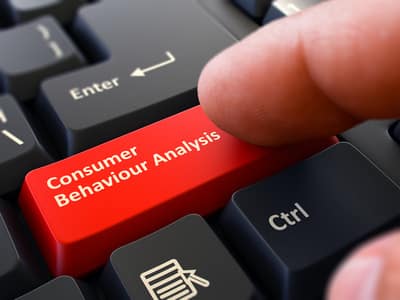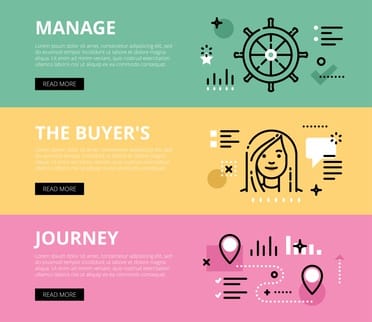Creating content for your buyer’s journey from stranger to loyal customer is about understanding your buyer, their needs and how they like to consume information. Your content marketing strategy will guide them along a road to understanding, and purchase.
A buyer’s journey takes them through three distinct stages from the moment they realize they have a problem to the moment they click ‘buy now”. At each stage of this journey, they’ll be seeking different information in different formats, it’s up to you to help them along the way.
Step 1: Understand Your Buyer Personas
Without a deep understanding of who your target market is, you’ll never reach optimum conversion rates. You should have an understanding of your customer’s problems, their methods of research, and their barriers to purchase. If you don’t, start by finding out. All your customers should be prompted to give you feedback about your product or service. Most organizations will be serving multiple buyer personas. It’s vital to understand which personas offer you the biggest potential profits and how they like to consume information. Without this understanding you could spend days or weeks creating incredible content that only attracts tire kickers.
Step 2: Map the Three Steps to Purchase
Awareness: Your buyer becomes aware that they have a need. At this stage, they research the need to better understand it. This content will be long, targeting larger head keywords.
Consideration: The next stage in your buyer’s journey is building a knowledge bank about potential solutions to their need. Here they will require more in depth information. By the end of this stage they should understand your product or service’s unique benefits and they should desire them. The keywords used at this stage are more specific long tail keywords that refer to specific areas of your product or service.
Decision stage: During this stage they are weighing up the benefits you provide against the benefits of your competitors. At this stage you should be stepping up your sales pitch and making sure they know you have the only solution that meets all their needs. Keywords at this stage are pure conversion keywords. Keywords here serve to attract potential customers who have already taken their buyer’s journey on a competitor’s website and are now looking around at options to compare.
Step 3: Gain a Deep Understanding of Their Problem
It’s time to eavesdrop on conversations about your competitors, your product or service. Keep notes on the language and content of the conversations that you find. Using the customer’s language to explain their problem will create a sense of understanding between your brand and your buyer.
- Google Adwords Keyword Planner, Search Term Autocomplete and Related Search Suggestions
- Social media groups frequented by potential customers
- Industry forums, review sites and news sites
- Trending content sites
- Question and answer sites including Yahoo Answers
- Twitter hashtag feeds
- Amazon reviews, competitor reviews and comments on blogs
- Paid tools including Aardvark and Wordtracker
Step 4: Understand How Google Sees the Buyer’s Journey
Once you have a list of questions, problems and comments, Google them. Use Google’s advanced understanding of search intention to see what your top ranking competitors are doing. Examine the top ranked content for subject matter, quantity and quality of technical information, multimedia formats, imagery, calls to action and other conversion tactics. Also not technical factors such as length, keyword targeting, trust elements, internal linking, inbound links and social media signals.
You now have a list of the content characteristics needed to rank in search engines. It’s a big mistake to assume that content marketing and SEO are two separate entities – just ask the million or so unread bloggers out there. Performing proper, in depth keyword research, using highly engaging and keyword rich titles and ensuring that all the SEO boxes are ticked is not optional. Search engines are your most powerful allies in getting buyers to enter your funnel.
Step 5: Develop your content plan
With the information you’ve gathered, create a simple framework for each piece of content. Each piece should take into consideration the stage of the buyer’s journey. It should address the questions and pain points at each stage. At this stage you should have keywords, page titles, headlines and a rough “mud map” of each piece of content.
Once you have all your content planned out, you should be able to see a series of clear pathways through the buyer’s journey. Your awareness stage content should naturally progress the buyer forward, ready to consume content at the consideration level. Map out your conversion paths. If there are gaps where awareness stage content requires further development, add that content to your plan.
By the end of this step you should have a series of clear, targeted and compelling paths for your customer to take on their journey. These paths will then become the on page calls to action that brings your sales funnel into clear, simple focus.
Step 6: Create and Measure your Content
By this stage, your content should essentially create itself. You should have a clear idea of how every word, every image or every frame will drive your buyer forward on their journey. The path should be clear, unobstructed by distracting web elements or unnecessary links. There should be no doubt in your customer’s mind how to take the next step on their buyer’s journey.
Once created, watch it like a hawk. Set tracking in Google Analytics and watch for any deviations from your specified path. Tweak, revise, test and recreate where needed. Your buyer’s journey is ever evolving and needs constant attention, however excellent content is the most effective way to compel them forward until she reaches that all important destination: Buy Now.
Author Bio: Dana Flannery, digital strategist at Talk About Creative. Dana has worked in marketing copywriting for more than a decade and carefully combines traditional marketing theory with digital marketing ingenuity.









































